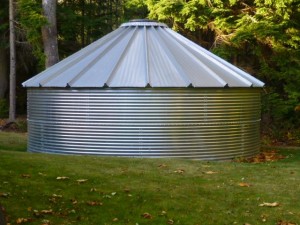 The GSI mandate or “Green Stormwater Infrastructure” can create unexpected costs for new commercial and residential construction. Controlling storm water through GSI compliance requires on-site infiltration and/or use.
The GSI mandate or “Green Stormwater Infrastructure” can create unexpected costs for new commercial and residential construction. Controlling storm water through GSI compliance requires on-site infiltration and/or use.
Roof runoff, along with impervious surfaces, contributes to overwhelmed stormwater systems, which may result in pollutants entering our waterways and wetlands. A design using both methods of rainwater collection and infiltration can be the most cost-effective, while being beneficial to the environment.
 Directing roof runoff for irrigation, toilets, laundry, or even pre-infiltration potable water, will reduce costs from municipal water supplies. During the rainy season, collected water can supply these uses while overflow from the cistern can be directed to infiltration. Irrigation in the summer months being supplied by the desired amount allocated from storage will enable the rain garden or infiltration system to be sized for a smaller amount of runoff while supplementing city water usage.
Directing roof runoff for irrigation, toilets, laundry, or even pre-infiltration potable water, will reduce costs from municipal water supplies. During the rainy season, collected water can supply these uses while overflow from the cistern can be directed to infiltration. Irrigation in the summer months being supplied by the desired amount allocated from storage will enable the rain garden or infiltration system to be sized for a smaller amount of runoff while supplementing city water usage.
Related

A rainwater collection systems designer and consultant, Ken has designed and installed residential and commercial systems, primarily in the northwest United States for more than 10 years and, in 2014, began consulting and managing builds in other states. Ken is an accredited ARCSA Professional Designer / Installer and Life Member, the Northwest Regional ARCSA representative and advisor to its education committee and is available to speak about Rainwater Collection Systems design and builds.
Ken is a United States Navy veteran, having served on active duty during the Vietnam War era.
A career entrepreneur, Ken created a new business focus with a commercial dive company in Hawaii in the mid 1980′s to respond to and clean up oil spills, oil spill equipment training, service and maintenance for the oil co-op service industry. Ken is passionate about having a positive impact on the environment and is also a founding director of BANK-ON-RAIN (2011-2014), whose mission is to create grassroots solutions for rainwater collection for consumption and agriculture in developing areas of the planet.
 The GSI mandate or “Green Stormwater Infrastructure” can create unexpected costs for new commercial and residential construction. Controlling storm water through GSI compliance requires on-site infiltration and/or use.
The GSI mandate or “Green Stormwater Infrastructure” can create unexpected costs for new commercial and residential construction. Controlling storm water through GSI compliance requires on-site infiltration and/or use. Directing roof runoff for irrigation, toilets, laundry, or even pre-infiltration potable water, will reduce costs from municipal water supplies. During the rainy season, collected water can supply these uses while overflow from the cistern can be directed to infiltration. Irrigation in the summer months being supplied by the desired amount allocated from storage will enable the rain garden or infiltration system to be sized for a smaller amount of runoff while supplementing city water usage.
Directing roof runoff for irrigation, toilets, laundry, or even pre-infiltration potable water, will reduce costs from municipal water supplies. During the rainy season, collected water can supply these uses while overflow from the cistern can be directed to infiltration. Irrigation in the summer months being supplied by the desired amount allocated from storage will enable the rain garden or infiltration system to be sized for a smaller amount of runoff while supplementing city water usage.
